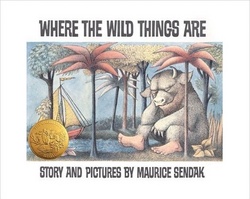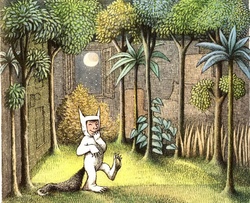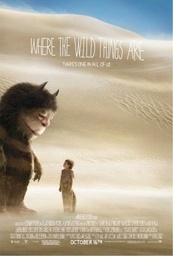“The night Max wore his wolf suit and made mischief of one kind or another.....” I have read this story so many times that I practically have it memorized. But despite that fact, I always enjoy reading
Maurice Sendak’s Where the Wild Things Are. I like how the book is full of a little boy’s imagination yet the illustrations Maurice Sendak includes are not all bright and magical. The colors are subdued and scratchy. The monsters themselves were considered too scary when the book was first published.
The illustrations serve as the main storytelling function during the Wild Rumpus that Max has with the Wild Things. These illustrations really support the notion of a big imagination of a child. Max’s imagined world is so vast it fills the page, there aren’t any white borders on the page once his “ceiling hung with vines and the walls become the world all around”!
The story is about a wolf-suit-wearing mischievous boy named Max. He runs amuck through the house. His mother tires of his shenanigans and sends him to his room without his supper. Of course Max is not happy and uses his imagination to travel to a place where he is all-powerful, tames the Wild Things “with the magic trick of staring into their yellow eyes without blinking once”, and is made king of all the wild things. Max grows tired of being all-powerful and wants to be “somewhere where someone loves him most of all” and goes back home where Mom lovingly has dinner waiting for him. At least that is what I got out of it.
Scholars have looked at this story and examined its many meanings. I was even involved in an online discussion about the meaning of the moon in the story. The debate focused on the meaning of the different phases of the moon from the beginning of the story to the end of the story. (I will wait while you dig up your copy of the book to check....yes that is a waning crescent in the beginning and a full moon at the end. And yes that means the moon had to go through many phases - new moon, waxing crescent, and waxing gibbous to get to a full moon phase or perhaps it went backwards in time - all while Max spent his time-out in his room). But I digress.
I went to see the
Where the Wild Things Are movie a few weeks ago and it has me thinking about meanings in the story even more. Of course it is a challenge to create a full length movie from just thirty five pages, so a back story about Max and his family was added and to my surprise, back stories about the Wild Thing monsters too! I never imagined the monsters having emotional baggage. Perhaps the monsters were Max’s problems personified, but I like Maurice Sendak’s description of the monsters better. They are caricatures of his
aunts and uncles. It IS freaky when aunts and uncles say “you are so cute, I could eat you up”! That was probably his inspiration.
So I am curious now. What do Ann Arbor.com readers take away from the Where The Wild Things Are by Maurice Sendak?
Lisa Bankey is a parent, an Enrichment Facilitator for the Ann Arbor Public Schools, and a librarian-in-training who blogs about Children’s Literature for AnnArbor.com. Lisa can be reached at lisabookblog@gmail.com.
book photos: amazon.com
movie photos: wherethewildthingsare.warnerbros.com




